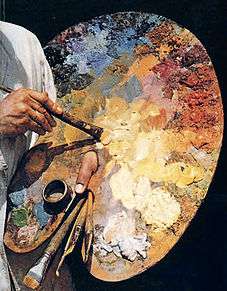Palette (painting)

A palette /ˈpælᵻt/, in the original sense of the word, is a rigid, flat surface on which a painter arranges and mixes paints. A palette is usually made of wood, plastic, ceramic, or other hard, inert, nonporous material, and can vary greatly in size and shape. The most commonly known type of painter's palette is made of a thin wood board designed to be held in the artist's hand and rest on the artist's arm. Watercolor palettes are generally made of plastic or porcelain with rectangular or wheel format with built in wells and mixing areas for colors.
From the original, literal sense above came a figurative sense by extension, referring to a selection of colors, as used in a specific art object or in a group of works comprising a visual style. This second, figurative sense is the one extended in the digital era to the computing senses of "palette".
Wet palette
A wet palette is a sealable container with a layer of absorbent material (such as tissue paper or sponge) that can be soaked with water and a semi-permeable membrane (such as parchment, greaseproof paper or baking paper (silicone paper)) over that. The paint sits on the membrane and is kept wet by osmosis. The main purpose of the wet palette is to keep acrylic paint, whose drying is unreversable, workable. Wet palettes are easily made, but can be bought.
Parallel palette
The parallel palette (invented by David Kassan) is a palette for oil painting, mounted vertically adjacent to the painting, so that the paints on the palette are in the same lighting as on the canvas, and so that the artist can look directly back and forth between subject, canvas, and palette.
See also
| Wikimedia Commons has media related to Painting palettes. |
External links
- Palette, Online Etymology Dictionary
- Colorpalettes.net, Color Palette Ideas, Color Selection.